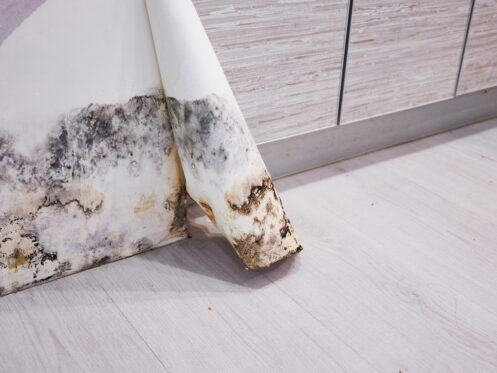Most people spend over 90% of their time indoors. However, your indoor environment could be two to five times more hazardous than your outdoor environment. For this reason, many homeowners prioritize improving their indoor air quality. Poor indoor air quality contributes to poor health, causing health problems like asthma, allergies, headaches, fatigue and poor sleep. Besides more obvious things like dust mites, cigarette smoke, and pet allergens, mold and mildew are among the major factors that affect indoor air quality. Mold can grow anywhere in your home — on carpet, clothing, paper, food, and even in areas you cannot see, like the areas inside walls around leaking pipes, the backside of drywall and above ceiling tiles.
Banishing mold can be a challenging task, so we have compiled our top tips for detecting and combating this common indoor air contaminant and improving your indoor air quality for good.
Signs That You Have Mold and Mildew Problems in Your Home
Most property owners often overlook mold and mildew until they become a significant problem. If you remain vigilant, you can detect and address mold early on, preventing potential health risks and extensive property damage. Some signs that you might have a mold and mildew problem in your home include:
- Unpleasant musty smells
- Worsening asthma symptoms or allergies
- Moisture problems
- Warped paint
- Spotted clothing
- Visible mold growth
- Unusual pet behavior or illness
Tips to Combat Mold and Mildew Growth and Enhance Indoor Air Quality
Here are some tips to help you inhibit mold growth in your home:
1. Dry Wet Areas Right Away
Mold thrives in wet conditions, so dry wet areas immediately. You should dry water accumulation from a leaking pipe, seepage into the basement following heavy rains, or even a spill on the carpet within 24 to 48 hours. Also, you should not leave wet items lying around your home and ensure you dry the walls and floors after a shower. Avoid leaving damp clothes in the washing machine, where mold can spread easily. Consider hanging them to dry, preferably in spaces with good air circulation.
2. Assess Your Ventilation
Your routine household activities can also encourage the growth of mold in your home. Ensure that a simple task like taking a shower, cooking dinner, or cleaning a load of laundry doesn’t promote mold growth by offering proper ventilation in your bathroom, kitchen, laundry room, and other high-moisture areas. In most instances, you can address this issue by improving ventilation through vents, windows, or underfloor ventilation. You can automate the ventilation in your bathroom by connecting it to the light in the room. Have a professional HVAC technician frequently inspect your ventilation and insulation systems to ensure they work correctly.
3. Keep Your HVAC System Clean
Routine HVAC maintenance can help keep humidity levels in your home in check. This includes regular inspections, filter changes, and coil cleanings. A clean heating and air conditioning system lowers the chances of mold spores circulating throughout your home. We recommend that you have your home’s comfort system professionally serviced by the On Time Experts team at least once every year.
4. Clean and Maintain Your Ductwork
Your air ducts are some of the most overlooked components of your heating and air conditioning system when it comes to maintenance. Oftentimes, ductwork can be a hidden source of mold and mildew. Routine inspections and professional cleanings can help you catch and resolve any mold issues early on. If there’s considerable mold growth, expert remediation might be needed.
When you schedule your annual HVAC maintenance with On Time Experts, we’ll inspect your air ducts as part of the process. You should have your ductwork professionally cleaned every three to five years, depending on the state of your ductwork and whether you’re dealing with chronic duct problems.
5. Control Humidity Levels
The EPA recommends keeping the humidity levels in your living space between 30% and 50%. Keeping proper indoor humidity levels is imperative to prevent the growth of mold and mildew, bacteria, and other harmful micro-organisms. You can monitor humidity levels in your home by using a hygrometer and take appropriate steps to maintain the recommended range. Also, you can detect excess humidity by paying attention to potential problem areas in your home. Some of the warning signs of high humidity include condensation on walls, windows, and pipes.
In many instances, addressing excess moisture is as simple as turning on your AC system. Your air conditioner can dehumidify your indoor air, though in a limited capacity. A dehumidifier offers an incredible way to control indoor humidity levels regularly. Dehumidifiers come in portable form or whole-house variants that get installed as part of your home’s AC system.
6. Increase Airflow in Your Home
The air tends to hold less moisture as temperatures decrease. Without proper airflow in your home, this excess moisture can appear on your floors, walls, and windows. To improve air circulation, move furniture away from walls, open doors between rooms, and open closet doors. Letting fresh air in will help minimize moisture and keep mold and mildew at bay.
7. Pay Attention to Indoor Plants
Although indoor plants can help keep your indoor air clean by filtering contaminants, they can also offer the ideal breeding ground for mold. To prevent this from happening, don’t allow excess water to stand in drip trays once you water your plants. Also, consider adding a dash of natural anti-fungal substance that can inhibit mold growth in the plant soil.
8. Clean Extractor Fans
Extractor fans in your bathroom or kitchen help filter humidity and nasty odors outside. Over time, they can get clogged and lose their efficiency. Have them cleaned and serviced regularly to keep them running efficiently.
9. Vacuum With a HEPA Filter
High-efficiency particulate air filters help prevent the accumulation of mold spores on the floor and in carpets. Also, you can use HEPA vacuum cleaners to clean vents and musty areas in your home that may contribute to mold and mildew growth. In addition, you can use portable HEPA air purifiers in areas prone to dampness without a fan vent, like the bathroom and basement.
10. Clean Your Home Regularly
Mold particles tend to settle where dust settles. The more that dust accumulates, the more mold spores and other pollutants can accumulate as well. By cleaning your home regularly to minimize dust, you can reduce the exposure your loved ones have to allergens like mold spores.
Rely on the Experts
Preventing mold growth in your home is essential for maintaining healthy indoor air quality and guaranteeing your family’s health. If you notice or suspect mold growth in your HVAC system or any other part of your Dallas area home, contact a professional at On Time Experts. We have the equipment and experience to keep your home comfortable and free of mold and mildew. We also offer a wide range of HVAC and plumbing services, including repairs, installations, and maintenance.

